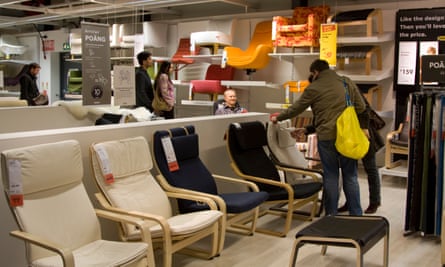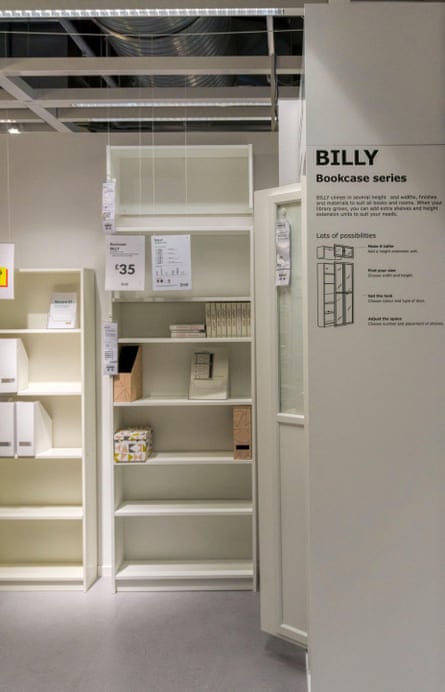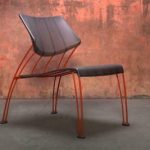Will Ikea’s recycling scheme really make it greener?
If spending more time at home has made you consider a furniture update, do not sling out that Billy bookcase just yet. Instead of taking it to the tip, you may be able to raise some cash through Ikea’s new buyback service. The scheme, which it announced last autumn, allows customers to take their furniture back to the store to be refunded and receive a voucher worth up to half of the item’s original value. It will then be resold to a new home, giving it “a second chance at life”.
The furniture retailer says the service will reduce waste and increase sustainability, and is part of its efforts to go greener. Last week it told the FT it was also looking at offering a wider range of spare parts to help people repair its products.
But does it need to do more to improve its green image? It has long come under fire for its environmental impact, consuming vast amounts of resources to mass-produce furniture that is not known for its durability.
Will other businesses take the lead?
Ikea’s success has been built on two factors: design and price. “Before Ikea came about, people used to inherit furniture or they would have to buy something really expensive,” says David Grimshaw, a programme leader in postgraduate product design at the Manchester School of Art. “Young people didn’t want houses that looked like their parents’, with highly decorative furniture, but they also didn’t have a huge amount of money.” Grimshaw says brands such as Habitat and Heal’s took on a more contemporary, functional design, but they had high prices. “Ikea came in with an affordability that really made it stand out,” he says. “Ikea allowed you to say: ‘We’re not going to live like our parents.’”
The minimal designs Ikea offered were not purely cooked up for style. To drive down the price, the company had to mass-produce its products, so needed to maximise the audience it could sell them to. The minimal design provided the answer, making its products suitable for a wide range of homes.
We’re unlikely to be wearing the same clothes in 10 years, or driving the same carDr Lucie Middlemiss
The flatpack model reduced production costs, and so, too, did the huge out-of-town stores. Consumers paid for their own transport and construction costs, enabling Ikea to undercut its competitors on price.
But low prices can lead to a feeling that an item is disposable and we can move on from it without too much thought. Lucie Middlemiss, a co-director of the Sustainability Research Institute at the University of Leeds, says: “We’re unlikely to be wearing the same clothes in 10 years, or driving the same car. There’s a faster turnover of stuff, and that’s where we have a problem.”
Middlemiss says that while Ikea’s buyback initiative is a step in the right direction, it risks “ending up being a tokenistic gesture”. A greater environmental impact, she says, would come if the retailer offered repairs, veneers to update the appearances of tired furniture or, as it is considering, small parts for fixes.
“I think there is a role for businesses to take the lead,” she says. “Because they don’t have much competition, Ikea might have the flexibility to raise prices a little bit to green its processes in some way. Often the green option is unaffordable, so it would be great if Ikea could crack it at a reasonably low price point.”
For businesses, there is a potential downside to producing more durable products, says Dr Francesco Nava, a professor of economics at the London School of Economics and Political Science. “With more durable products, it becomes tricky to sustain profit margins because, in the end, everyone has the products.”
He says Ikea offers good quality for the prices it charges and is unlikely to be toppled soon by a firm with a more sustainable approach. “It’s hard to have a green furniture process at a smaller price bracket for consumers, so, at the moment, I don’t see big global players in the furniture market that could buy customers away,” he says.
 View image in fullscreenReturning your used furniture could earn you cash back from Ikea. Photograph: Robert Stainforth/Alamy
View image in fullscreenReturning your used furniture could earn you cash back from Ikea. Photograph: Robert Stainforth/Alamy
‘A cheap product I can leave behind’
One of those customers is Alexa Downie Ngini, a 22-year-old auditor living in London in rental accommodation. For her, the attraction of Ikea is its price and convenience.
“I’m renting and moving flats every year,” she says. “For me, what I need is a cheap product that I can buy that I don’t care about leaving behind when I move. I don’t mind moving smaller items, like mirrors, with me when I go but not something large like a desk. I don’t have a car, nor do many people renting in London.”
The lack of transport also turns Ngini off secondhand products, which often require collection.
“When I shop at Ikea, we go and do it all in a day. If I get secondhand stuff, I have to drive all around London getting it,” she says. “It is so inconvenient for me to try to buy more expensive items, or secondhand items, and then transport them, that I’d take the environmental cost.”
While secondhand might remain in second place for now, Grimshaw suggests that local initiatives could provide the best competition for the furniture retailer.
With a rise in the popularity of digital cutting machines, furniture plans can be found online and built by local manufacturers using local materials. The machines are more adaptable than those found in mass production, meaning that furniture can be made bespoke – offering an alternative to “ubiquitous” Ikea.
“Here, you’re transporting data around the world, not raw materials, which drops the level of emissions,” he says. “I think that could be a threat to Ikea.”
‘Climate positive by 2030’
Hege Sæbjørnsen, the country sustainability manager of Ikea UK and Ireland, says it is “committed to becoming fully circular and climate positive by 2030”, with all products being made from renewable, recyclable or recycled materials.
Low price does not mean low quality or unsustainable productsIkea’s Hege Sæbjørnsen
“They will be designed to be reused, refurbished, remanufactured or recycled,” she says. “We’ve signed up to science-based targets, with goals that span over our entire value chain – from the extraction and processing of raw materials, to our zero-waste-to-landfill policy, from the stores and touchpoints where we meet our customers, to the use and end-of life of our products.”
According to Sæbjørnsen, 97% of the firm’s wood came from “more sustainable sources” last year, and it uses a recovery department, which repacks returned products to avoid them going to waste, and offers spare parts to enable customers to fix existing products.
“Low price does not mean low quality or unsustainable products, just as high price does not mean high quality and sustainable products. We strongly believe that sustainability cannot be a luxury for the few,” she says.
Beyond Billy bookcase
 View image in fullscreenIkea sells one of its Billy bookcases every five seconds worldwide. Photograph: UrbanImages/Alamy
View image in fullscreenIkea sells one of its Billy bookcases every five seconds worldwide. Photograph: UrbanImages/Alamy
According to Ikea, one Billy bookcase is sold every five seconds – probably because buyers can bag one for £35. But what more sustainable options are out there?
For a model of the same dimensions at Unto This Last, an independent furniture maker that uses a digital cutting machine to produce its own flatpack furniture, buyers would face a £190 bill.
Etsy boasts an array of independent sellers, with bookshelves made from recycled materials generally costing between £100 and £200.
Buying secondhand has long been a solution to the sustainability question. With the rise of Facebook Marketplace and local “free stuff” groups, this is only getting easier. Or you can use charity shops – Oxfam and the British Heart Foundation are among those running standalone furniture outlets.
There has also been a rise in the popularity of upgrading and personalising Ikea products. IKEAhackers.net offers suggestions for modifying your old Ikea furniture from upcycling fans around the world – from updating tired products to repurposing the parts to use for something new.
How the buyback scheme works
Ikea’s buyback scheme was due to launch in November but has been put on hold because of the Covid-19 restrictions. It is expected to launch sometime this year.
If you return a white Billy bookcase that cost £35 to buy and now has minor scratches, you will get about £14 back, or £17 if the product is as good as new. The oak-effect Kallax shelving unit, £55 new, will fetch you £16 if it is well used, or £27 if you return it in good condition.
You can find an estimated price for your product online but the final amount will be decided by an Ikea employee when you bring your it into the store. If you decide to go ahead with the scheme, Ikea will take back your assembled item and resell it at a reduced price, and you will get the value on a gift card.




